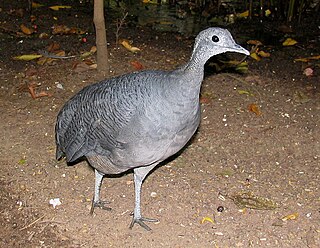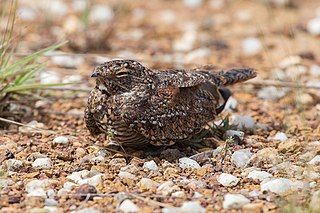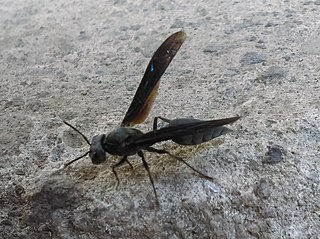
The prairie skink is a species of skink endemic to the prairies east of the Rocky Mountains in North America. It is one of only seven species of lizards that occur in Canada.

Jainosaurus is a genus of titanosaurian sauropod dinosaur of India and wider Asia, which lived in the Maastrichtian. It is thought to have been about the same size as its contemporary relative Isisaurus, measuring 18 metres (59 ft) long and weighing 15 metric tons. The humerus of the type specimen is 134 centimetres long.

Chironius is a genus of New World colubrid snakes, commonly called sipos, savanes, or sometimes vine snakes. There are 23 described species in this genus.

The grey tinamou is a type of ground bird native to South America. Four subspecies are recognised.
Stegophilus is a genus of pencil catfishes native to South America.

The least nighthawk is a species of nightjar in the family Caprimulgidae. It is found in Argentina, Bolivia, Brazil, Colombia, Guyana, Suriname, and Venezuela.

The rufous-tailed stipplethroat, formerly called the rufous-tailed antwren, is a species of insectivorous bird in subfamily Thamnophilinae of family Thamnophilidae, the "typical antbirds". It is found in Brazil, Colombia, Ecuador, and Peru.

The northern sportive lemur, also known as the Sahafary sportive lemur or northern weasel lemur, is a species of lemur in the family Lepilemuridae. It is endemic to Madagascar. As a result of severe ecological and human pressures, the lemur is classified as Critically Endangered (CR) by the IUCN Red List.

Myotis septentrionalis, known as the northern long-eared bat or northern myotis, is a species of bat native to North America. There are no recognized subspecies. The northern long-eared bat is about 3–3.7 inches in length, with a wingspan of 9–10 inches. It is distinguishable by its long ears when comparing it to other bats in its genus. This species is commonly found in the northern United States and Southern Canada east of British Columbia. The geographic range includes 37 states.

Cnesterodon is a genus of poeciliids native to South America.

Synoeca is a genus of eusocial paper wasps found in the tropical forests of the Americas. Commonly known as warrior wasps or drumming wasps, they are known for their aggressive behavior, a threat display consisting of multiple insects guarding a nest beating their wings in a synchronized fashion, and an extremely painful sting. The sting is barbed and if used often kills the wasp, which may be the reason why such a striking defensive display is used. This display escalates from drumming inside the nest to hundreds of wasps moving on to the envelope of the nest and continuing to drum. If this does not deter the threat only then do the wasps begin to sting.

Synoeca septentrionalis is one of five species of wasps in the genus Synoeca. It is a swarm-founding wasp that is also eusocial, exhibiting complicated nest structure and defense mechanisms and a colony cycle including a pre-emergence phase and a post-emergence phase. It is typically found in areas from Central to South America. This wasp is one of the larger species of paper wasps and exhibits multiple morphological adaptations as a result of this. Synoeca septentrionalis is known for possessing a very painful sting.

The Ilha Maracá gecko is a species of lizard in the family Sphaerodactylidae. The species is endemic to northern South America.
Synoeca ilheensis is a species of wasp in the genus Synoeca. It is found within the Atlantic Forest lowlands in South America. Members of this species are more aggressive and will warn invaders by producing a rhythm with their wings that resembles soldiers marching. Synoeca ilheensis was publicly announced on August 3, 2017.
Cnesterodon carnegiei, commonly known as Carnegie's toothcarp, is a species of poeciliid native to southeastern Brazil and Uruguay.
Cnesterodon raddai, the Resistencia toothcarp, is a species of poeciliid native to the Paraguay and lower Paraná River basins.
Cnesterodon hypselurus, the Cilida toothcarp, is a species of poeciliid native to the Paranapanema River basin in Brazil.
Cnesterodon iguape, the Iporanga tooth carp, is a species of poeciliid from the upper Rio Iporanga in Brazil.
Cnesterodon brevirostratus, is a species of poeciliid found in Brazil.

Cnesterodon decemmaculatus, the ten spotted live-bearer, is a species of poeciliid native to Argentina and Uruguay.











